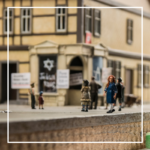KIDS OF COURAGE - TV series
– Docudrama 8 x 25′
– Delivery: autumn 2018
– Written by: Matthias Zirzow, Maarten van der Duin, Ramona Bergmann
– Directed by: Matthias Zirzow
– Produced by: LOOKSfilm
– Co-produced by: SWR, TOTO Studio, EC1 Lodz – City of Culture, CeTA
– Worldwide distribution: LOOKS International GmbH
– Distribution in Poland: MOMAKIN
All figurines, models and mock-ups were created in Poland, as well as the effect shots – sequences using miniature models and figurines.
ut not the people, vehicles or animals.
POLISH CREW
Companies:
– TOTO Studio & EC1 Lodz – City of Culture & CeTA – co-producers
– Studio Scenografii i Form Unikatowych – models, props, backgrounds
– Pracownia.11 – large scale figurines (main characters)
– Playade – Polish language version
– Momakin – executive producer and distributor in Poland
People:
– Agata Gorządek – Production Designer (responsible mainly for the visual consistency of model sequences)
– Marcin Jasiński – Art Department Leadman
– Jan Paweł Trzaska – DoP (special effects photography on models)
ABOUT THE PROJECT
 KIDS OF COURAGE is a docudrama for kids, based on children’s diaries and memories. It combines three visual elements: drama, archives and models.
KIDS OF COURAGE is a docudrama for kids, based on children’s diaries and memories. It combines three visual elements: drama, archives and models.
The model worlds are created by a highly skilled artists from Poland, whose experience include, among other, set building for beautiful story of “The Flying Machine” and the Oscar-award winning animation “Peter and the Wolf”.
 What does it mean to be a war child? This docudrama for children about the Second World War will deliberately set the official version of history against a young and international perspective and show how children experienced the war in Europe.
What does it mean to be a war child? This docudrama for children about the Second World War will deliberately set the official version of history against a young and international perspective and show how children experienced the war in Europe.
The series focuses on the experiences of eight children and their day-to-day lives during the Second World War: on their reaction to the war, to hunger, bombing raids, loss, escape, persecution or terror.
 The biographical stories of the child protagonists are accompanied by models. This three-dimensional “model world” is particularly suitable for recording the emotions of main characters and, for example, setting them in the context of the events of the war.
The biographical stories of the child protagonists are accompanied by models. This three-dimensional “model world” is particularly suitable for recording the emotions of main characters and, for example, setting them in the context of the events of the war.
The internal and external world of the Second World War will be made to feel real through the situational, atmospheric visual illustration in the form of a three-dimensional model world, through the “frozen” snapshots of people and processes while at the same time providing a “moment of peace” between the drama and archive sequences.
 A major preoccupation of the model worlds will be to excite the imagination of the young audience, using the artistic abstraction of the events and so to deepen their identification with and analysis of the contents. At the same time, a certain dream-like ambiance is created, which supports precisely this, and “playfully” counteracts any traumatisation. Elements like day and night, fog and water change and move, but not the people, vehicles or animals.
A major preoccupation of the model worlds will be to excite the imagination of the young audience, using the artistic abstraction of the events and so to deepen their identification with and analysis of the contents. At the same time, a certain dream-like ambiance is created, which supports precisely this, and “playfully” counteracts any traumatisation. Elements like day and night, fog and water change and move, but not the people, vehicles or animals.
